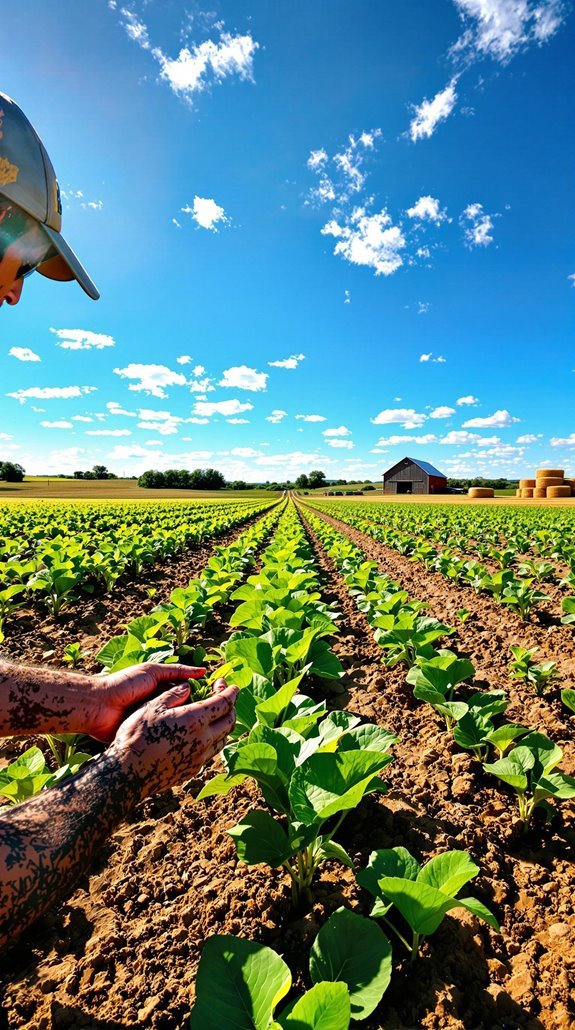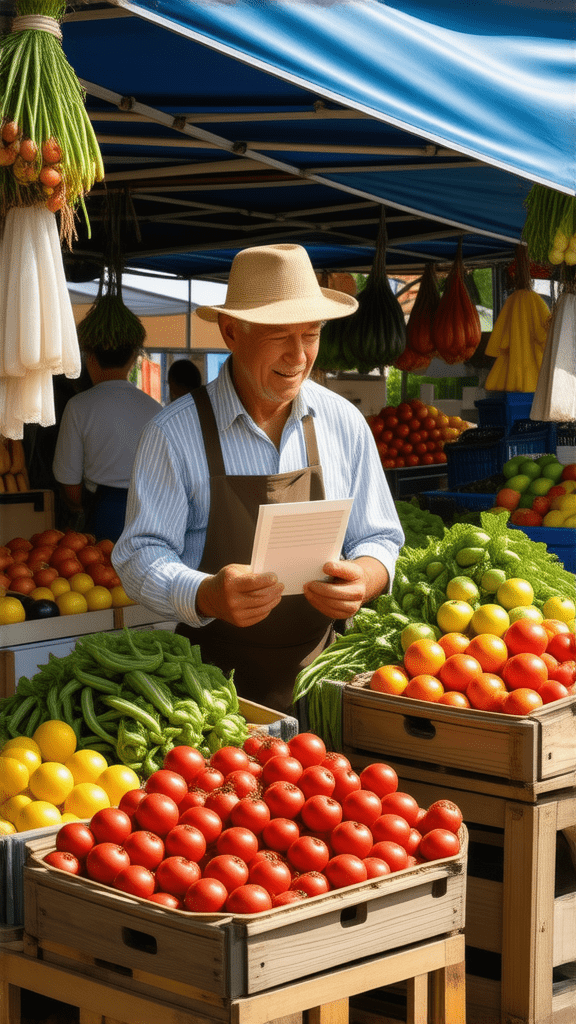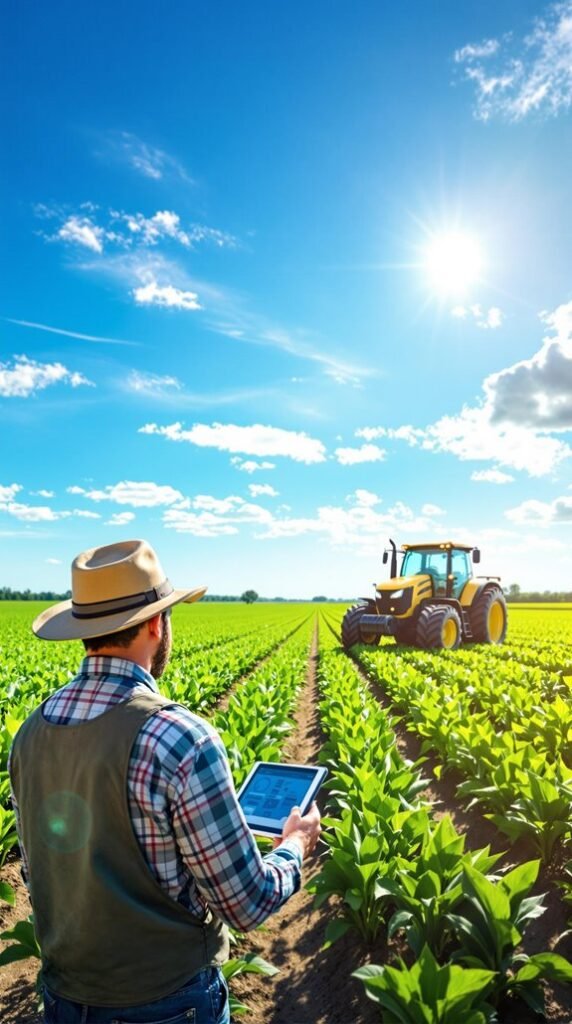Agricultural lines of credit are a game changer for your farm’s future growth. Think of them as your financial cushion that can help you manage those unpredictable times or when you need to invest in new equipment. With flexible repayment options, you can tailor payments to fit your cash flow. They’re perfect for covering essential costs like seeds, labor, and even unexpected repairs. Plus, with interests only on what you use, you save a bit of dough. So, whether you’re looking to expand or just keep things running smoothly, there’s more to uncover about maximizing these financial tools!
When John’s irrigation system failed during peak planting season, he didn’t know how to recover the costs without jeopardizing his harvest. An agricultural line of credit helped him cover repairs, secure supplies, and keep operations on track. Learn how this flexible financial tool is transforming challenges into opportunities for farmers like John.
Understanding Agricultural Lines of Credit

In the world of agriculture, managing cash flow can be a challenge, and that’s where agricultural lines of credit come in.
Think of it as your financial safety net, ready to catch you during those tight moments. Unlike a traditional loan, these lines of credit function like a credit card, offering you revolving credit. You can draw from your specified limit at any time, paying interest only on the amount you actually use. This flexibility helps farmers to manage seasonal fluctuations in their operations without straining their finances.
With the support of operating lines of credit, you can ensure that you have the necessary funds for critical input costs like seeds and fertilizers. Additionally, these lines of credit serve as a financial lifeline during unpredictable market conditions or weather events.
When it comes to credit options, you can choose between secured and unsecured lines, which help tailor your financing needs to your unique farm planning.
Want to snatch up seeds when they’re cheap? You can do that! Plus, accessing your funds is a breeze—you can use debit cards or simply hop online. And for those who like a little excitement, many lines come with variable interest rates that change with the market.
Key Uses for Financing
Agricultural lines of credit serve multiple purposes, making them a vital resource for farmers looking to manage their finances effectively.
You can use these funds to cover day-to-day expenses like seeds, fertilizers, and feed for your livestock. Whether you’re paying salaries or covering transportation costs, having access to quick financing helps streamline your operations without breaking the bank.
But that’s not all! These lines of credit can support your farm investments as you look to upgrade equipment or improve facilities. Imagine finally getting that shiny new tractor or converting an old barn into a high-tech storage space. Talk about growing with style! Effective management of interest rates is crucial for agricultural businesses, and a line of credit can help you navigate these complexities.
You’ll also find that lines of credit are essential for navigating those pesky seasonal fluctuations. They offer cash flow management during lean months, serving as an emergency fund when unexpected challenges arise. Additionally, a farm line of credit provides flexibility in cash flow management when it’s time to expand your operations or dive into new projects, so you’ll appreciate the financial flexibility that comes with these credit lines. Having access to farm operating loans ensures you can maintain consistent cash flow and focus on long-term goals for your farm.
In the ever-changing world of agriculture, utilizing financing is a smart way to enhance your agricultural resilience and ensure your farm thrives for years to come.
Benefits of Revolving Credit

Understanding the advantages of agricultural lines of credit helps you see why revolving credit is a game changer for farmers.
With the flexibility it offers, you can draw funds as needed, smoothing out those cash flow bumps that seem to pop up right when your crops are high! You won’t pay interest on the unused portion, so that’s a bonus for your credit score—more money in your pocket when it matters most.
The variable interest rate means you only pay for what you use. Since interest is paid only on the funds used, you can maximize your savings even further. The term or loan period for an RLOC is typically one year or longer, providing further adaptability to suit your operational needs.
Forget about those rigid repayment schedules; you can tailor payments to fit your cash flow, allowing breathing room during those lean months. Plus, it’s a great tool for financial leverage, helping you seize opportunities like snagging new equipment at a sale. By maintaining a good credit history, you can improve your farm’s capital position, making it easier to secure loans in the future.
Don’t underestimate the safety net it provides against unexpected costs. Ever had a crop failure? Or maybe a piece of equipment decided to retire? With revolving credit, you’re not left high and dry. You can handle those surprises with ease, keeping your farm thriving.
Expenses Covered by Lines of Credit
When it comes to farming, managing expenses can feel like herding cats—challenging but necessary. Lines of credit can help cover your daily operational expenses, seasonal needs, and project development costs, keeping your farm running smoothly. Think of it as having a financial safety net, so you can focus more on those pesky crops and less on crunching numbers!
Farm operating loans can provide capital for a range of agricultural-related expenses, making it easier to plan for growth and sustainability. With a farm operating line of credit, farmers can easily access funds as needed, enabling them to react swiftly to unexpected costs. Moreover, having a detailed business plan in place can help farmers make informed decisions about their financial health and credit preparation.
Daily Operational Expenses
Lines of credit can be a lifeline for farmers managing daily operational expenses.
They allow you to cover urgent costs while waiting for that next big harvest. Think about those moments when you need flexibility the most.
- Fuel and Energy: Keeping all those machines running isn’t cheap, and energy bills can sneak up on you.
- Labor Costs: Whether it’s hiring farm workers or paying for seasonal help, wages are a constant consideration.
- Repairs and Maintenance: Equipment upgrades and necessary repairs can hit you hard when you least expect it.
These daily expenses don’t just disappear; they need to be managed effectively to keep your operation on its feet. Fixed costs must be accounted for, as they remain constant regardless of production levels. Understanding your operating expense ratio is crucial for effective financial management.
With a line of credit, you can take a breath and address your immediate needs. Don’t let a broken tractor or an unexpected bill send you into a tailspin.
Use the support of a line of credit to tackle daily operational demands while ensuring that your farm flourishes.
Seasonal Financial Needs
Managing seasonal financial needs is crucial for keeping your farm running smoothly during peak production times. After all, you don’t want to be left in a lurch when crop cycles demand a little extra cash.
That’s where agricultural lines of credit step in, making it easier for you to stick to your farm budgets without breaking a sweat.
Whether you’re buying seeds, fertilizers, or those pesky pesticides, lines of credit can cover your seasonal input costs.
Need to hire extra labor during busy months? You’ve got it! From veterinary expenses to livestock purchases, these funds provide the flexibility you need. Additionally, an operating line of credit is typically repaid when the crops are sold, allowing for effective management of cash flow.
They’ve even got your back in emergencies—like crop failures or those unexpected equipment breakdowns that always seem to happen right before harvest.
Plus, when you face those unexpected market downturns, you can breathe easily.
With a line of credit, you can smooth out cash flow and manage tax liabilities, so you can focus on what you love: farming. Additionally, many small depository institutions can avail themselves of seasonal lending programs to better handle significant fluctuations in financial needs.
Project Development Costs
Farmers often find themselves facing substantial project development costs that can strain budgets—this is where agricultural lines of credit play a vital role. With these lines of credit, you can tackle various expenses linked to your farm’s growth, allowing you to focus on what truly matters: nurturing your crops and livestock.
- Land Acquisition and Development: Need to expand? Lines of credit can finance land purchases and the essential preparation work to make it farm-ready. Revolving lines of credit help provide ongoing access to funds for these investments.
- Irrigation and Water Development: Keeping plants hydrated is crucial. You can fund infrastructure to ensure irrigation infrastructure to ensure your crops flourish without the stress of running dry.
- Feed and Livestock Expenses: Keeping your livestock happy (and fed) means spending on feed and veterinary care, which can all be covered by your line of credit.
Ultimately, these credit solutions offer the flexibility and support you need to invest strategically in your farm’s future. So, why stress over upfront costs when there’s a better way to finance your growth? Your farm’s potential is waiting—let’s make it happen!
Ensuring Operational Stability

Ensuring operational stability in agriculture hinges on effective financial management during seasonal and cyclical fluctuations. Think of it as riding a rollercoaster—you’ll have those thrilling highs and some gut-wrenching lows. Operating lines of credit are crucial tools to help you cover essential expenses like seeds, labor, and even that odd broken tractor part you didn’t see coming.
You can draw funds as needed, which makes managing cash flow during lean times much easier. As we enter a period where loan demand has risen sharply, it’s critical to reassess your financing strategies. One way to enhance your strategy is by utilizing an operating line of credit that provides available loan funds to support your business throughout the entire operating cycle.
Farm risks, like fluctuating commodity prices or that surprise hailstorm, can throw a wrench into your plans. However, maintaining financial resilience allows you to weather these storms.
Remember, you’re not alone in this. Almost 70% of banks report lower farm liquidity, so staying on top of your finances is more important than ever. Utilizing secured lines of credit tied to your assets can help lower costs and provide flexibility. Yes, banks take a keen interest in your financial health, but so should you! Loans help bridge the gap between income and expenses throughout the year with a loan agreement that outlines the terms of repayment.
Flexible Repayment Options
Navigating cash flow in agriculture can be challenging, but having flexible repayment options in your lines of credit makes it much easier.
With these options, you can customize your repayment schedules to match your farm’s unique financial rhythm. After all, you wouldn’t want to pay back a big loan when your tractor just broke down, would you?
- Customizable Payment Plans: Choose from monthly, quarterly, or annual payments that suit your cash flow demands. You can even manage interest-only payments during construction for up to one year. Conventional Mortgage offers competitive interest rates, providing you with more savings as you grow your operations. By analyzing financial statements from prior years, you can identify peak and slow periods, helping you make informed decisions about your repayment plan.
- No Prepayment Penalties: This means you won’t get hit with fees for paying off your credit line early, giving you more financial flexibility.
- Alignment with Cash Flow: Your repayment plan can be designed to fit your farm’s cash flow cycles, so you can access funds for ongoing needs without a hitch. Agricultural Line of Credit provides interest paid only on what is used, allowing further financial relief. Having a business line of credit can provide quick access to funds when needed, helping you manage cash flow during off-seasons and peaks.
With these options, you’re not just managing cash flow; you’re enhancing your farm’s growth potential with ease. Let’s ensure those cows stay happy and your balance sheet does too!
Navigating Market Fluctuations

When it comes to navigating market fluctuations, you’ll want to keep your cash flow in check while also seizing those golden seasonal opportunities. Think of it as balancing on a seesaw; too much weight on one side, and you could tip over! As interest rates increase around 4 percentage points from 2022 to the end of 2023, it’s essential to consider how higher interest rates may impact your financing options. With farm banks experiencing a 6.7% growth in agricultural lending in 2023, there are emerging opportunities to strengthen your financial position. Having a solid business plan in place can help you make informed decisions and stay ahead of market changes.
Managing Cash Flow Variability
How can you effectively manage cash flow variability in agriculture, especially with the ever-changing market conditions?
One word: strategy! With a well-built cash flow projection, you’ll better navigate the seasonal variations that can throw a wrench into your plans.
1. Develop a Comprehensive Cash Flow Budget****: List all your expected income sources and expenses.
Break things down monthly to account for those pesky seasonal ups and downs.
2. Optimize Your Expenses: Take a hard look at your costs.
Cut any unnecessary expenses, and compare your costs with competitors to check if you’re in the ballpark.
You might find opportunities to negotiate better lease payments!
3. Leverage Financial Tools: Don’t shy away from using farm operating loans wisely.
They can be your lifeline during low-income periods.
And remember, not all lenders are created equal—shop around for the best rates!
Funding Seasonal Opportunities
In the ever-shifting landscape of agriculture, funding seasonal opportunities can make all the difference in maintaining a thriving operation.
When cash flow is tight during planting or harvest seasons, a well-structured line of credit can be your financial lifesaver. You can cover essential expenses like fertilizer, feed, or even equipment repairs without breaking a sweat. Plus, you’ll be ready to pounce on livestock purchases when prices dip, ensuring your farm growth isn’t stunted.
Market fluctuations can be unpredictable, but with flexible repayment options and revolving credit, you can adapt quickly.
Some lines of credit even have no mandatory paydowns—allowing you to breathe a little easier during leaner months. Talk about a safety net! You’ll have the funds to manage labor costs during peak seasons and tackle other seasonal expenses like irrigation supplies, so nothing slips through the cracks.
Additional Financial Services Available
While exploring agricultural lines of credit, you’ll find a variety of additional financial services tailored to meet your specific needs.
These services can be a real lifesaver in ensuring that you manage risks effectively while growing your farm.
- Ag Real Estate Loans: Whether you’re looking to purchase new land or refinance existing debt, these loans can give you the funds needed to make those dreams a reality, with terms extending up to 25 years.
- Ag Machinery and Equipment Loans: Need to upgrade your equipment or expand your livestock? These loans cover up to 75% of the fair market value, and payment schedules can be structured for up to seven years, making it manageable for your budget.
- Agribusiness Leasing: If buying isn’t in the cards right now, leasing equipment for three to five years can keep your cash flow healthy—and guess what? Those lease payments might even be tax deductible.
Additionally, don’t forget about Farm Insurance as a critical part of your risk management strategy.
It helps protect these investments, making sure you’re covered when the unexpected happens.
Many farmers also explore alternative lending options, such as CDFI Loans, which prioritize community needs and offer flexible requirements compared to conventional banks.
Qualifying for Agricultural Credit

Qualifying for agricultural credit can often feel daunting, but understanding the requirements is key to securing the funding you need.
First, lenders will run credit checks, so you should know where you stand. A credit score of at least 660 is usually required, but if you’re aiming for a smoother process, shoot for 700 or higher.
Your farm history also plays a significant role here. Lenders like United Ag Lending might expect a minimum score of 680, but they may also place weight on your farming experience, sometimes more than your credit score.
You’ll need to provide a solid farm business plan, detailed financial projections, and even documents showing your assets.
You should also be aware that some lenders have a minimum loan requirement, often around $500,000, and your property should be at least 25 acres for agricultural use.
Folks, if you’ve owned the land for ages, that can boost your chances!
Maintaining a good credit utilization rate, such as keeping credit use below 30% of available credit, can also contribute to a stronger credit profile and improve your chances of qualifying for agricultural credit.
Strategies for Future Growth
Looking to grow your farm?
Diversifying your crop production and expanding your livestock operations can be great ways to boost your profits and keep things interesting on the farm—
After all, who wouldn’t want a barnyard full of different critters?
Having a business line of credit in place can provide the necessary financing to support your growth initiatives and help you navigate seasonal cash flow fluctuations.
Diversifying Crop Production
Diversifying crop production is a crucial strategy for ensuring long-term agricultural growth and resilience.
By mixing things up on your farm, you not only boost your yields but also improve your soil health.
1. Crop Rotations: Switch between different crops each season. This can increase your yields by up to 25% during tough weather and enhance soil health, reducing erosion. Plus, it keeps your labor demands from going through the roof!
2. Agroforestry and Intercropping: By planting trees alongside your crops, you’ll create a habitat for wildlife while improving soil health.
Also, intercropping can slow pest spread—it’s like a natural pest management plan in action!
3. Focus on Soil Health and Biodiversity****: Adding cover crops and perennials helps build organic matter and enhances microbial activity.
Healthier soil means healthier plants, not to mention a more stable yield.
Embracing crop diversity doesn’t just help your bottom line; it’s also a hedge against climate unpredictability.
Expanding Livestock Operations
Expanding livestock operations presents numerous opportunities for growth and increased profitability.
By focusing on Capacity Replication, you can take your successful model and plant it in new areas. It’s like cloning your herd—only without the sci-fi implications! This approach helps you manage smaller units more effectively while spreading fixed costs across multiple locations.
Another powerful strategy is Intensification Integration.
This means producing more with the same assets, often by upgrading your technology. Think of it as giving your barn a high-tech makeover. By modernizing, you not only boost your output but also reduce costs, making your operation leaner and meaner. You’ll be amazed at how much more your livestock can accomplish with the right gadgets!
Using an ag line of credit calculator can help you strategize, so let’s turn that farm equity line of credit dream into a reality!
Agriculture Line of Credit Calculator
Primo Agriculture Line of Credit Calculator
Loan Information
| Loan Amount | |
|---|---|
| Interest Rate (%) | |
| Loan Term (Years) | |
| Fees (Optional) |
So, which option serves you better?






